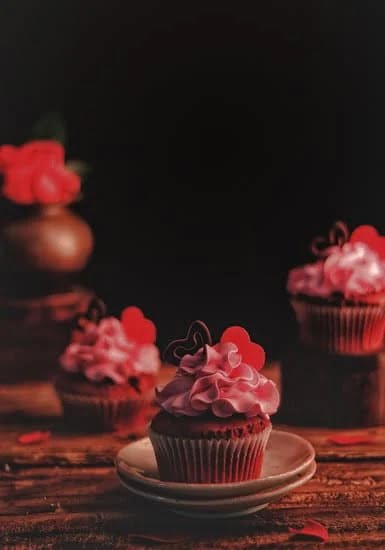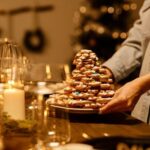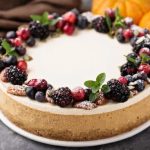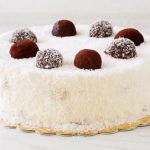Welcome to the world of Christmas cake decoration. In this blog post, we will delve into the art of decorating a Christmas cake with royal icing.
The festive season calls for beautiful and intricate designs adorning our cakes, and royal icing is the perfect medium to bring those visions to life. Whether you are a beginner or an experienced baker looking to up your cake decorating game, this guide will provide you with all the tips, techniques, and inspiration you need.
Christmas cake decoration holds a special significance in many cultures, symbolizing joy, celebration, and tradition. It is a delightful way to showcase creativity and transform an ordinary cake into a showstopper centerpiece for your holiday table. Royal icing, made from egg whites and powdered sugar, offers numerous advantages when it comes to decorating cakes. Its smooth texture allows for precise detailing, while its quick drying time ensures your designs stay intact.
Before diving into the intricacies of royal icing decoration, let’s first gather the necessary tools and materials. From piping bags and tips to food coloring gel and edible glitter, we will provide you with a comprehensive list of essentials needed for optimal results. Knowing what equipment and ingredients to use is crucial in ensuring that your decorations turn out flawless.
Get ready to embark on a creative journey as we explore the world of decorating Christmas cakes with royal icing. You’ll be amazed at what you can achieve with just a few simple techniques and some festive inspiration. So let’s dive in and discover how you can transform your holiday desserts into edible works of art.
Tools and Materials Needed for Decorating a Christmas Cake with Royal Icing
Decorating a Christmas cake with royal icing requires certain tools and materials to ensure a smooth and successful process. To achieve the best results, it is essential to gather all the necessary equipment before starting the decoration process.
Equipment
- Offset spatula: An offset spatula is ideal for spreading and smoothing royal icing onto the cake’s surface. Its angled blade allows for easy application without disturbing the cake underneath.
- Piping bags and tips: Piping bags are used for creating detailed designs and patterns with royal icing. Different sizes of piping tips can be used to achieve various effects, such as writing messages or adding intricate decorations.
- Palette knife or scraper: A palette knife or scraper is helpful for achieving a smooth, level surface on the cake before applying royal icing. It allows you to remove any excess frosting or bumps on the cake’s surface.
Ingredients
- Royal icing: The main ingredient needed for decorating a Christmas cake with royal icing is, of course, the icing itself. You can either make your own using powdered sugar, egg whites, and lemon juice or purchase pre-made royal icing mix.
- Food coloring: Depending on your desired design, you will need food coloring to create vibrant and festive colors for your royal icing. Gel-based food coloring works best as it provides more intense colors without altering the consistency of the icing.
- Flavorings and extracts (optional): To add extra flavor to your royal icing, you may choose to incorporate extracts such as vanilla or almond. This step is optional but can enhance the overall taste of your decorated Christmas cake.
Preparing the Christmas Cake for Decoration
Before you can begin decorating your Christmas cake with royal icing, it is important to properly prepare the cake for icing. This step is crucial in ensuring a smooth and level surface for applying the icing and achieving professional-looking results.
To start, make sure your cake is completely cooled before you begin the decoration process. A warm or hot cake will cause the royal icing to melt, making it difficult to work with. Once your cake has cooled, remove it from the baking pan and place it on a flat surface.
Next, you’ll want to level your cake if necessary. Using a serrated knife or a cake leveler, carefully trim off any dome-shaped top to create an even surface. This will help prevent any unevenness in the final icing layer.
After leveling, it’s time to crumb coat your cake. This involves applying a thin layer of buttercream or ganache all over the cake to seal in any loose crumbs. The crumb coat provides a smooth base for the royal icing and helps ensure that no crumbs will be visible once the final decoration is complete.
Once you’ve applied the crumb coat, chill your cake in the refrigerator for at least 30 minutes to allow it to set. This will make it easier to apply and work with the royal icing later on.
| Tools | Materials |
|---|---|
| – Serrated knife | – Buttercream or ganache for crumb coat |
| – Cake leveler | – Optional: marzipan or fondant for an additional base layer |
| – Offset spatula or palette knife | – Clear alcohol (such as vodka) for thinning or cleaning the icing |
| – Cake board or serving plate | – Icing smoother or bench scraper for smoothing the icing |
These tools and materials will help you achieve the best results when preparing your Christmas cake for decoration with royal icing. With a properly prepared cake, you’ll be ready to move on to mixing and coloring the royal icing.
Mixing and Coloring Royal Icing for Christmas Cake Decoration
Royal icing is a classic choice for decorating Christmas cakes due to its smooth texture and ability to hold intricate designs. In this section, we will guide you through the process of mixing and coloring royal icing to achieve the desired look for your festive cake.
To make royal icing from scratch, you will need the following ingredients: powdered sugar (also known as confectioner’s sugar), pasteurized egg whites or meringue powder, and flavoring extract (such as vanilla or almond). The powdered sugar provides the base for the icing, while the egg whites or meringue powder act as a stabilizer. The flavoring extract adds a delicious taste to the icing.
Once you have gathered your ingredients, follow these steps to mix royal icing:
- Sift the powdered sugar into a large mixing bowl to remove any lumps.
- Add the pasteurized egg whites or meringue powder gradually while beating on low speed with an electric mixer.
- Continue beating until stiff peaks form, which means that when you lift the beaters out of the mixture, peaks remain standing upright.
- Add your desired flavoring extract and beat for another minute to incorporate it evenly.
Now that your basic royal icing is ready, it’s time to add some color. Gel-based food coloring works best for tinting royal icing since it doesn’t change the consistency of the mixture like liquid food coloring does. Start with small amounts of gel coloring and gradually add more until you achieve your desired shade.
To create vibrant and festive colors using royal icing, consider using different icing dye options such as:
- Traditional Christmas colors: red and green
- Snowy hues: white or light blue
- Elegant metallics: gold or silver Remember that a little bit of food coloring goes a long way with royal icing, so start with small additions and gradually adjust until you achieve the desired color intensity. Keep in mind that overmixing the icing can cause air bubbles, so mix gently and avoid excessive stirring.
Achieving the perfect colors for your Christmas cake decorations requires practice, but with these tips and techniques, you’ll soon be able to create stunning and eye-catching designs using royal icing.
Essential Techniques for Applying Royal Icing to a Christmas Cake
Applying Royal Icing to a Christmas cake requires certain techniques to achieve professional-looking results. Whether you’re a beginner or an experienced decorator, mastering these essential techniques will elevate your cake decorating skills and make your Christmas cake truly stand out.
Piping
Piping is the most common technique used when working with royal icing. It involves using a piping bag fitted with different types of tips to create intricate designs and patterns on the cake. Start by filling the icing into the piping bag, ensuring it is tightly sealed.
Hold the bag at a 45-degree angle and apply consistent pressure to pipe the icing onto the cake surface in smooth, controlled movements. Practice on a parchment paper before starting on the actual cake to get comfortable with piping techniques and achieve clean lines.
Flooding
Flooding is another technique that involves using royal icing to cover larger areas of the cake with a smooth and even layer. To flood an area, first, outline it with a thicker consistency of royal icing called “piping consistency.” Then, thin down the remaining icing slightly with water to achieve “flooding consistency.”
Using a spoon or squeeze bottle, pour the thinned down icing onto the outlined area and use an offset spatula or toothpick to spread it evenly towards the edges. This technique creates a sleek and flawless look for backgrounds or when covering large surfaces.
Detailing
Detailing is all about adding intricate decorations and fine details using royal icing on your Christmas cake. For this technique, it’s important to have steady hands and work patiently as you create small designs like snowflakes, holly leaves, or delicate lettering on your cake. Use fine-tipped piping bags or small brushes for precision detailing work. Keep in mind that practicing beforehand will help improve your control over the flow of royal icing and ensure accuracy in your designs.
These essential techniques for applying royal icing to a Christmas cake will help you achieve professional-looking results and make your cake a centerpiece of admiration during the holiday season. Practice each technique to master it, and don’t be afraid to experiment with different designs and patterns to create your own unique masterpiece.
Keep in mind that with practice, patience, and a little creativity, you can create stunning decorations that will impress your guests and transform your Christmas cake into a work of art.
Decorating Ideas and Inspiration for a Christmas Cake
When it comes to decorating a Christmas cake with royal icing, the possibilities are truly endless. With some creativity and inspiration, you can transform a plain cake into a festive masterpiece that will be the centerpiece of your holiday table. In this section, we will explore a variety of design ideas and offer tips on how to combine different techniques to create visually stunning results.
- Festive Shapes and Symbols One of the most popular decorating ideas for Christmas cakes is incorporating festive shapes and symbols. Consider using cookie cutters to create shapes such as snowflakes, holly leaves, or even Santa Claus. These shapes can be made using fondant or marzipan, then placed strategically on the cake to create an eye-catching design. You can also use stencils to add intricate patterns such as candy canes, reindeer, or ornaments.
- Winter Wonderland Theme For a magical winter wonderland look, you can cover your cake with a layer of white royal icing to mimic snowy landscapes. Use a palette knife or spatula to create texture that resembles snow drifts. Add edible shimmer dust to give the cake a sparkling effect. Additionally, you can incorporate edible sugar pearls or silver dragees to represent snowflakes glistening in the winter sun.
- Elegant and Modern Designs If you prefer a more elegant or modern look for your Christmas cake, consider using metallic accents or monochromatic colors. Gold or silver leaf decorations on fondant-covered cakes create an opulent feel, while shades of white or pastel colors give off an elegant vibe. You can also experiment with geometric patterns by using stencils and contrasting colors.
- Traditional Holiday Motifs To capture the traditional charm of Christmas, go for classic motifs such as wreaths, poinsettias, stockings, or gingerbread houses. Trace these designs onto parchment paper and pipe over them with royal icing. As an alternative, you can also use silicone molds to create 3D decorations like Santa Claus figurines or miniature Christmas trees.
Remember, the key to successful Christmas cake decoration is to plan ahead and allow yourself enough time for practice. Don’t be afraid to experiment and try different techniques and designs. With some creativity and a little bit of patience, you can create a Christmas cake that will impress your guests and be remembered for years to come.
Troubleshooting Common Issues in Royal Icing Decoration
Decorating a Christmas cake with royal icing can be a fun and rewarding experience, but sometimes things don’t go as planned. In this section, we will explore some common challenges that readers may encounter during the decorating process and provide solutions to fix them.
One common issue that may arise is smudging or bleeding of colors. This can happen when the royal icing is too wet or when different colors of icing come into contact with each other before they’ve had a chance to dry. To prevent smudging, make sure to let each layer of icing dry completely before adding another color on top. Additionally, you can use a fan or blow dryer on low heat to speed up the drying process.
Air bubbles are another common problem when working with royal icing. These pesky bubbles can ruin the smooth surface of your cake decorations. One way to prevent air bubbles is to mix your royal icing thoroughly and then let it sit for a few minutes before using it. This allows any air bubbles to rise to the surface, which you can then remove by gently tapping the bowl on the counter or using a toothpick to pop them.
Uneven surfaces are also something that decorators may struggle with. Sometimes, despite our best efforts, the surface of our cakes just isn’t perfectly level. If you find yourself dealing with an uneven surface, try using an offset spatula or palette knife dipped in warm water to smooth out any bumps or imperfections. You can also try adding an additional layer of icing to even things out.
By addressing these common issues and providing practical solutions, readers will be equipped with the knowledge and techniques needed to troubleshoot their own royal icing decoration problems. Remember, practice makes perfect, so don’t get discouraged if things don’t turn out exactly as planned at first. With patience and perseverance, you’ll soon be creating beautifully decorated Christmas cakes that will impress family and friends alike.
Finishing Touches and Presentation Tips for a Showstopper Christmas Cake
After putting in all the effort to decorate your Christmas cake with royal icing, it’s important to give it those final finishing touches that will truly make it a showstopper. Adding extra embellishments and paying attention to presentation can elevate your cake from just another holiday dessert to a centerpiece that will impress all your guests.
One way to add some sparkle and glamour to your Christmas cake is by incorporating edible glitter. Edible glitter comes in various colors and adds a magical touch to any design. Simply sprinkle it over the icing in a desired pattern or use a small brush to apply it more precisely. Edible glitter will instantly make your cake shimmer and stand out.
Another fun idea for adding a festive touch is by incorporating sugar ornaments. These can be either store-bought or homemade using molds or piping techniques. Sugar ornaments like miniature snowflakes, reindeer, or Christmas trees can be strategically placed on top of the cake or around the sides to create an eye-catching effect.
In addition to decorative elements, considering how you present your Christmas cake is also crucial. A beautifully decorated cake deserves an equally stunning display. Invest in a decorative cake stand that complements the theme of your cake and enhances its overall aesthetics. Alternatively, you can place the cake on a simple white platter adorned with fresh holly leaves or red berries for a more natural and rustic look.
Lastly, don’t forget about personalization. Add a personalized message or seasonal greeting on top of your cake using writing icing or fondant letters. This allows you to customize the cake for any special occasion or recipient, making it even more special.
Remember, these finishing touches are an opportunity for you to get creative and showcase your own style and personality through your Christmas cake decoration. The key is not to go overboard but rather ensure that each element complements the overall design of the cake.
By incorporating these finishing touches and paying attention to presentation, you’ll be able to create a showstopper Christmas cake that not only tastes delicious but also visually impresses everyone. So go ahead, have fun, and let your creativity shine as you add those final details to make your Christmas cake truly unforgettable.
Conclusion
In conclusion, decorating a Christmas cake with royal icing is a true art form that can elevate any holiday gathering and impress guests with its stunning visual appeal. Throughout this blog post, we have explored the tools and materials needed for this task, learned how to prepare the cake for decoration, and discovered essential techniques for applying royal icing. We have also delved into decorating ideas and troubleshooting common issues that may arise during the process.
By following the step-by-step instructions provided in this guide and using your creativity, you can master the art of decorating a Christmas cake with royal icing. The key to success lies in practice and experimentation. Don’t be afraid to try different techniques, mix colors, or combine patterns to create your own unique design that reflects your personal style.
Remember, the beauty of royal icing decoration lies not only in achieving clean lines and intricate designs but also in adding those finishing touches that make your cake truly stand out. Whether it’s edible glitter, sugar ornaments, or personalized messages, these embellishments will add that extra touch of elegance to your masterpiece.
So go ahead and embrace the art of decorating a Christmas cake with royal icing. With patience, passion, and attention to detail, you can create a showstopper dessert that will become the centerpiece of your holiday celebration. Happy baking.
Frequently Asked Questions
Can you put royal icing straight onto a fruit cake?
Yes, you can definitely put royal icing straight onto a fruit cake. Fruit cakes are often used as a base for royal icing because their dense texture provides stability and support for the icing.
The fruit cake needs to be completely cooled before applying the royal icing to prevent it from melting or becoming too soft. It’s also recommended to brush the fruit cake with a layer of apricot jam or marzipan to create an even surface and help the icing stick better.
What is the easiest way to decorate a Christmas cake?
The easiest way to decorate a Christmas cake is by using ready-made decorations such as figurines, edible glitter, or pre-made sugar paste decorations. These can easily be placed on top of the cake without requiring much skill or effort in terms of decorating techniques.
Another simple method is using stencils to spray patterns onto the cake with edible food coloring spray. This creates an attractive design without needing intricate piping skills.
How far in advance can you Royal Ice a Christmas cake?
It is generally recommended to royal ice a Christmas cake at least one week in advance but up to three months ahead if desired. The longer the icing has time to set and dry, the better it will be for maintaining its shape and preventing cracking when cut into slices later on.
Once you have applied the royal icing, allow it to dry completely before storing or covering with fondant or other decorations. Remember to keep the iced cake in a cool and dry place away from direct sunlight to preserve its freshness and quality over time.

Welcome to our cake decorating blog! My name is Destiny Flores, and I am the proud owner of a cake decorating business named Cake Karma. Our mission is to provide delicious, beautiful cakes for all occasions. We specialize in creating custom cakes that are tailored specifically to each customer’s individual needs and tastes.





